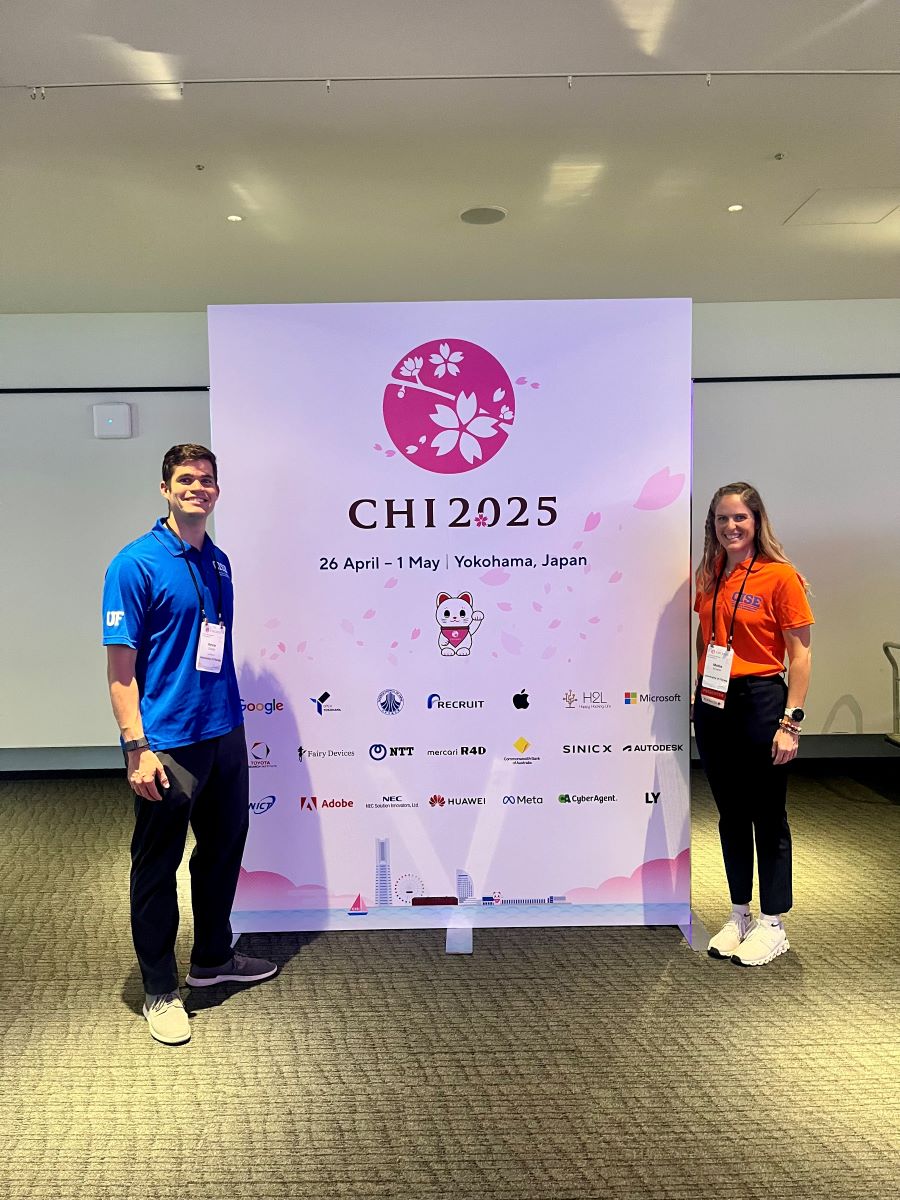From sidelines to spreadsheets: UF doctoral students take AI coaching research from the court to Japan
New study examines how coaches are using data and technology to maximize player performance and safety.
Shortly after the confetti settled over the University of Florida’s basketball championship, two graduate students studying artificial intelligence traveled to Japan to discuss how coaches are using data and technology to maximize player performance and safety.
Accomplished athletes themselves, UF engineering students Mollie Brewer and Kevin Childs are co-primary investigators on a paper exploring how coaches analyze data – often from wearable sensors – to shape training and strategy and, ultimately, win more games.
If a player comes off an intense workout, for example, coaches can look at the data and determine if that player needs rest before the next game. This means successful coaches – like those coaching the championship basketball team – are adding “data analyst” to their roles.
Brewer and Childs’ paper was selected for presentation at the renowned Association for Computing Machinery CHI conference in Yokohama, Japan, which ran April 26 to May 2. It was a big deal, not just because UF students are getting an international spotlight on their AI in Athletics research but also because the pair’s very first research paper was chosen for a highly competitive world conference.
“This is a look into how coaches use technology within collegiate athletics.” —Kevin Childs, doctoral student in the Herbert Wertheim College of Engineering
“This is a look into how coaches use technology within collegiate athletics,” Childs said. “We have a lot of studies talking to recreational athletes. We have some studies within the human computer-interaction area looking at professional sports. But we don't really have an understanding of how technology is used in systems like collegiate athletics.”
Brewer added: “And we’re not going to lie, bringing it to a conference on the back of a national championship is even more exciting.”
Brewer and Childs are UF Ph.D. engineering students and key players in the $2.5 million UF & Sport Collaborative initiative that, among other things, explores how AI data can maximize athletic performance and reduce injuries.

Known as the AI-Powered Athletics project, this partnership between the Herbert Wertheim College of Engineering and the University Athletic Association (UAA) delves deep into wearables such as fitness trackers and other sensors attached to athletes to provide information for AI databases.
“This paper was on the coach's perspective of what types of technology and data are being used in collegiate athletics,” Brewer said. “We're presenting how the landscape of data flows in this environment and also finding the opportunities to improve technology and data usage among these top-level coaches.”
The researchers worked with five teams and 17 coaches. For privacy, they were not able to reveal what teams participated.
But a March article on floridagators.com reported UF’s basketball team utilizes data for decisions on the court and in training. Heading into the SEC Tournament in March, for example, coaches used the data to increase intensity at practices to ensure optimum stamina if the team had to play three games in three days (which they did).
As data analysts, coaches are figuring out what the numbers mean for individual athletes, particularly the relationship between intensity and injury.
“They're intaking data from dozens of sources and processing this to figure out the optimal training plan,” Childs said. “For example, there are GPS IMUs – inertial measurement units – being worn by a lot of student athletes. They are little vests with sensors between the shoulder blades. It captures all their position data, how fast they jump, how fast they're moving.”
Another conclusion: Coaching is not a one-person job in collegiate athletics.
“There's an entire interdisciplinary team, and that information is shared among everybody to make decisions, and sometimes the same technology output is used by different roles,” Brewer said. “A dietician may use it one way. An athletic trainer may use the output for return to play, but they're all communicating together.”
Brewer is a cyclist, and Childs was a competitive swimmer. They know the ins and outs of competition and results. This research sharpens the competitive edge, that “last-second buzzer beater – anything you can do to get that extra 1%,” Childs said.
“We are so proud of Mollie and Kevin's innovative thinking and hard work,” said UF Department of Computer & Information Science and Engineering Professor Kristy Boyer, Ph.D., one of collaborators on the paper. “This project exemplifies what can happen when university faculty and innovators within the athletic association come together with a common goal.”
In addition to Brewer, Childs and Boyer, the paper’s other collaborators are Kevin Butler, Ph.D., from the Department of Computer & Information Science and Engineering, Garrett F. Beatty, Ph.D., from UF’s College of Health and Human Performance, Spencer Thomas from the UAA and Jennifer Nichols, Ph.D., Daniel Ferris Ph.D., and Celeste Wilkins from UF’s J. Crayton Pruitt Family Department of Biomedical Engineering.
As for exploring Japan?
“The experience was amazing,” Childs said. “Some of the highlights were traveling to random spots on a map with Mollie and trying out different food. Conveyor-belt sushi offered a fun game of guessing what variety of seafood was on the plate, and I think I satisfied my yearly quota of ramen consumption.”
“We loved connecting with new faces at CHI and getting inspired by the exciting research on the horizon,” Brewer added. “After our presentation, we ran out to join our new friends for a jog around the bay, just in time to catch a rare view of Mt. Fuji at sunset. It felt like the universe's quiet nod of ‘well done.’”

